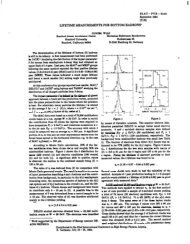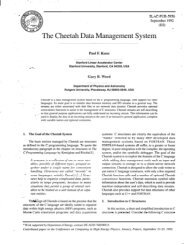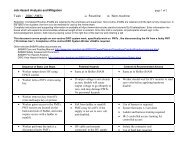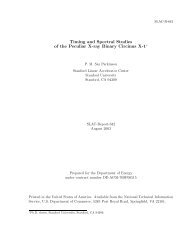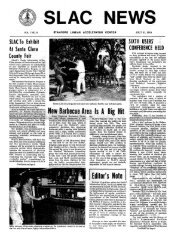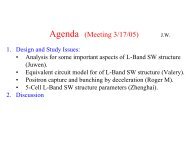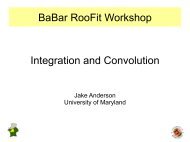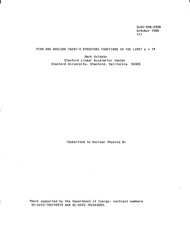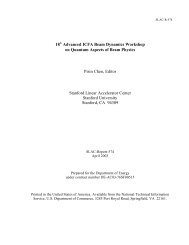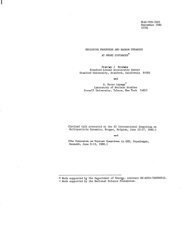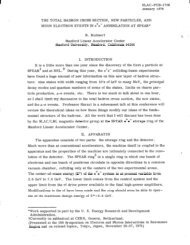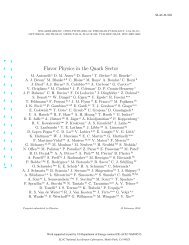The Use and Calibration of the Kern ME5000 Mekometer - SLAC ...
The Use and Calibration of the Kern ME5000 Mekometer - SLAC ...
The Use and Calibration of the Kern ME5000 Mekometer - SLAC ...
You also want an ePaper? Increase the reach of your titles
YUMPU automatically turns print PDFs into web optimized ePapers that Google loves.
-<br />
INTRODUCTION<br />
Wben it was introduced in 1986 <strong>the</strong> <strong>Kern</strong> <strong>ME5000</strong> <strong>Mekometer</strong> immediately attracted attention from<br />
<strong>the</strong> survey groups <strong>of</strong> accelerator laboratories around <strong>the</strong> world. This interest was generated not only<br />
because <strong>the</strong> ‘<strong>ME5000</strong> <strong>of</strong>fered bigber accuracy than any o<strong>the</strong>r distance measuring instrument on -<strong>the</strong><br />
market, but also because, unlike previous instruments, its measuring range extended down to just a few<br />
meters, thus opening up <strong>the</strong> wbole realm <strong>of</strong> accelerator housings to high-accuracy EDM measurements.<br />
Abbougb <strong>Kern</strong> quoted a range <strong>of</strong> 20-8000 m, s<strong>of</strong>tware was quickly made available to extend <strong>the</strong><br />
measurement range below 20 m (<strong>the</strong> PROMEKO program developed by <strong>the</strong> Technical University <strong>of</strong><br />
Munich).<br />
In 1988-89 three DOE laboratories (CEBAF, FNAL <strong>and</strong> LBL) acquired instruments. ‘Since none <strong>of</strong><br />
<strong>the</strong>se laboratories bad equipment to calibrate <strong>the</strong>se instruments whereas <strong>SLAC</strong> did, extensive tests were<br />
made witb all three instruments at <strong>SLAC</strong> in 1989.’ When four o<strong>the</strong>r laboratories initiated tbe<br />
procurement process in tbe second half <strong>of</strong> 1991 to buy <strong>the</strong>ir own machines, plans were set in motion to<br />
make a full series <strong>of</strong> test measurements with all DOE instruments, bringing <strong>the</strong>m to <strong>SLAC</strong> one at a time.<br />
Measurements commenced in January 1992 when <strong>the</strong> LBL, FNAL <strong>and</strong> CEBAF insmmrents were<br />
measured in quick succession. Tbe ANL <strong>and</strong> BNL instruments, both new, followed in February <strong>and</strong><br />
March. In June <strong>SLAC</strong> received its own instrument <strong>and</strong> measurements began right away.<br />
As what was to have been <strong>the</strong> culmination <strong>of</strong> this project, a workshop was held at <strong>SLAC</strong> in mid-June<br />
to discuss tbe results. 16 people from 7 DOE laboratories attended as well as one representative from <strong>the</strong><br />
Pohang Light Source in Korea (see <strong>the</strong> list <strong>of</strong> participants on p. iv). By this time measurements were<br />
complete for five instruments <strong>and</strong> mostly complete for a sixth (<strong>the</strong> <strong>SLAC</strong> instrument). This volume is <strong>the</strong><br />
for@ record <strong>of</strong> tbesix papers that were presented during <strong>the</strong> two days <strong>of</strong> <strong>the</strong> workshop. Tbe first paper<br />
covers <strong>ME5000</strong> Operation - how <strong>the</strong> instrument works. <strong>The</strong> second describes <strong>the</strong> measurements that were<br />
made at <strong>SLAC</strong> with eacbinstrument. Data analysis is described in <strong>the</strong> third <strong>and</strong> fourth papers, <strong>and</strong> <strong>the</strong><br />
results are presented in <strong>the</strong> fifth paper. <strong>The</strong> final paper is a special invited paper commissioned from<br />
Chris Curtis <strong>of</strong> CEBAF who spent three years (1987-89) working with a <strong>ME5000</strong> on <strong>the</strong> Channel Tunnel<br />
project in Engl<strong>and</strong>.<br />
<strong>The</strong> Workshop proved not to be tbe culmination <strong>of</strong> <strong>the</strong> project for two more instruments were<br />
measured in August - <strong>the</strong> two SSC instruments. <strong>The</strong> workshop papers presented in this volume have heen<br />
updated to incorporate <strong>the</strong>se results. <strong>The</strong> baseline measurements for tbe <strong>SLAC</strong> instrument have not heen<br />
completed <strong>and</strong> sufficient time has elapsed that <strong>the</strong>y must be started afresh, something that is not feasible<br />
in <strong>the</strong> next few months. <strong>The</strong>se updated proceedings <strong>the</strong>refore represent <strong>the</strong> culmination <strong>of</strong> this project to<br />
test tbe <strong>ME5000</strong> instruments at use in each DOE laboratory.<br />
<strong>SLAC</strong><br />
September 22,1992<br />
’ T.W. Copel<strong>and</strong>-Davis, Can <strong>the</strong> <strong>Kern</strong> <strong>ME5000</strong> Mekometa Replace Invar Measuremnts? Rcpulu<br />
Machines, Procedings <strong>of</strong> <strong>the</strong> First Intemational Wonkshop on AccelcrtirAlignmmt, <strong>SLAC</strong>, July 31 - August 2, 1989, pp. 171-183.<br />
7<br />
d Test ~mmnts witi l’hree



